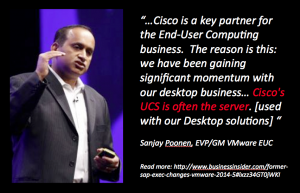Maciej Kranz, VP and GM of Cisco’s Corporate Technology Group, shares his perspective on Dundee Precious Metals and the Internet of Everything
I’ve traveled a great deal around the globe in the last year and am amazed at the interesting things organizations are doing with technology to connect the unconnected. As we enter the next big phase of the Internet – the Internet of Everything (IoE) – no industry can afford to be left behind. Even the industries that existed long before the Internet was even a glimmer on the horizon, such as manufacturing and mining, can realize great value through IoE. Dundee Precious Metals (DPM) is one example. They’re a manufacturing company that has capitalized on the connections between the people, process, data and things that IoE is enabling, transforming one of the world’s most traditional industries in the process.

When DPM set a goal to increase production of their flagship mining operation by 30 percent, their IT team needed to find a way to reach the target without increasing manpower or the number of vehicles.
With the help of the connections from IoE, now Dundee can share important information in real time, such as miners’ locations, equipment updates and data such as the number of buckets filled. This lets their teams troubleshoot as they go, instead of just at the end of a shift, keeping crews better on track to meet daily goals. What’s more, miners and mine managers had limited communication options since their Wi-Fi didn’t function well underground. So they leveraged Cisco’s unified wireless network to provide coverage along 50 kilometers of tunnels. This let drivers, supervisors and managers communicate efficiently – above ground or below – with calls and instant messaging. Radio Frequency Identification (RFID) tags placed on miners’ caps and vehicles keep everyone synced up with location tracking via a 3D map for improved worker safety. New collaboration capabilities extend to other DPM locations, making face-to-face collaboration possible between managers, geologists and metallurgists as they discuss production, development and project schedules. This all adds up to better understanding and decision-making across the board.
So what have these changes meant for DPM?
- Production increased by 400 percent, far exceeding their original 30 percent goal.
- Miner safety has improved as they track miners’ movements and know where everyone is at all times.
- Asset utilization of vehicles has also improved via continually transmitted data identifying repair needs.
- Communication and energy costs have been lowered through more efficient use of resources.
This is just the start of DPM leveraging IoE’s capabilities. The company plans to replicate the same systems in all of its mines, as well as extend the Internet of Everything concept to health monitoring of employees, using connected environmental health sensors.
The Internet of Everything is not just the technology of tomorrow. It is here today, and the networked connections it provides can impact all industries, even those industries with roots from long ago.
Read the full case study here: http://www.cisco.com/web/tomorrow-starts-here/manufacturing/index.html
Join the conversation on Twitter with the hashtag #InternetofEverything.
Read more #InternetofEverything Perspectives
Transforming Property Management with IoE by Roger Vasquez — Director of Engineering of Transwestern
Integrating Cities with IoE and City24/7 by Tom Touchet — CEO of City24/7
Driving Smarter with Technology and UPS by Dave Barnes — CIO of UPS
Share:
 I’m thrilled to be able to kick off this series and am looking forward to following the conversations that ensue. Given my focus on local government, I am particularly passionate about the issues facing cities and local government leadership, and feel that technology can be a very formidable force when it comes to enabling positive change to enhance and improve our communities.
I’m thrilled to be able to kick off this series and am looking forward to following the conversations that ensue. Given my focus on local government, I am particularly passionate about the issues facing cities and local government leadership, and feel that technology can be a very formidable force when it comes to enabling positive change to enhance and improve our communities.
 Going to
Going to 




CONNECT WITH US